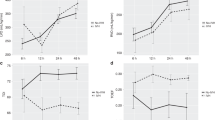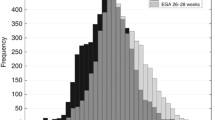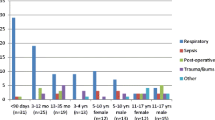Abstract
Unstable cerebral blood flow is theorised to contribute to the occurrence of intraventricular haemorrhage (IVH) in extremely low-birth-weight infants (ELBWIs), which can be caused by increased arterial flow, increased venous pressure, and impaired autoregulation of brain vasculature. As a preliminary step to investigate such instability, we aimed to check for correlations of cerebral blood volume (CBV), as measured using near-infrared spectroscopy, with the flow velocities of the anterior cerebral artery (ACA) and internal cerebral vein (ICV), as measured using Doppler ultrasonography. Data were retrospectively analysed from 30 ELBWIs uncomplicated by symptomatic patent ductus arteriosus, which can influence ACA velocity, and severe IVH (grade ≥ 3), which can influence ICV velocity and CBV. The correlation between tissue oxygen saturation (StO2) and mean blood pressure was also analysed as an index of autoregulation. CBV was not associated with ACA velocity; however, it was significantly correlated with ICV velocity (Pearson R = 0.59 [95% confidence interval: 0.29–0.78], P = 0.00061). No correlation between StO2 and mean blood pressure was observed, implying that autoregulation was not impaired.
Conclusion: Although our findings are based on the premise that cerebral autoregulation was unimpaired in the ELBWIs without complications, the same result cannot be directly applied to severe IVH cases. However, our results may aid future research on IVH prediction by investigating the changes in CBV when severe IVH occurs during ICV velocity fluctuation.
What is Known: • The pathogenesis of IVH includes unstable cerebral blood flow affected by increased arterial flow, increased venous pressure, and impaired cerebral autoregulation. • The approaches that can predict IVH are under discussion. | |
What is New: • ACA velocity is not associated with CBV, but ICV velocity is significantly correlated with CBV. • CBV measured using NIRS may be useful in future research on IVH prediction. |




Similar content being viewed by others
Availability of data and material
All data are within manuscript; data are available upon reasonable request to the corresponding author.
Abbreviations
- ACA:
-
Anterior cerebral artery
- AGA:
-
Appropriate for gestational age
- CBF:
-
Cerebral blood flow
- CBV:
-
Cerebral blood volume
- EDV:
-
End-diastolic velocity
- ELBWI:
-
Extremely low-birth-weight infant
- HHb:
-
Deoxyhaemoglobin
- ICV:
-
Internal cerebral vein
- IVH:
-
Intraventricular haemorrhage
- NIRS:
-
Near-infrared spectroscopy
- O2Hb:
-
Oxyhaemoglobin
- PDA:
-
Patent ductus arteriosus
- PSV:
-
Peak systolic velocity
- RI:
-
Resistance index
- SGA:
-
Small for gestational age
- StO2 :
-
Tissue oxygen saturation
- tHb:
-
Total haemoglobin
- TRS:
-
Time-resolved spectroscopy
References
Kenet G, Kuperman AA, Strauss T, Brenner B (2011) Neonatal IVH – mechanisms and management. Thromb Res 127:S120–S122. https://doi.org/10.1016/s0049-3848(11)70032-9
Bolisetty S, Dhawan A, Abdel-Latif M, Bajuk B, Stack J, Oei JL, Lui K, on behalf of the New South Wales and Australian Capital Territory Neonatal Intensive Care Units’ Data Collection (2014) Intraventricular hemorrhage and neurodevelopmental outcomes in extreme preterm infants. Pediatrics 133:55–62. https://doi.org/10.1542/peds.2013-0372
Kusuda S, Fujimura M, Uchiyama A, Totsu S, Matsunami K (2012) Trends in morbidity and mortality among very-low-birth-weight infants from 2003 to 2008 in Japan. Pediatr Res 72:531–538. https://doi.org/10.1038/pr.2012.114
Inder TE, Perlman JM, Volpe JJ (2018) Preterm intraventricular hemorrhage/posthemorrhagic hydrocephalus. In: Volpe’s Neurology of the Newborn, 6th edn, pp 637–698.e21. Elsevier
Ando Y, Takashima S, Takeshita K (1985) Cerebral blood flow velocity in preterm neonates. Brain Dev 7:385–391. https://doi.org/10.1016/s0387-7604(85)80135-2
Altit G, Bhombal S, Chock VY (2022) Cerebral saturation reflects anterior cerebral artery flow parameters by Doppler ultrasound in the extremely premature newborn. J Perinatol 42:237–242. https://doi.org/10.1038/s41372-021-01145-z
Ikeda T, Amizuka T, Ito Y, Mikami R, Matsuo K, Kawamura N, Fusagawa S (2015) Changes in the perfusion waveform of the internal cerebral vein and intraventricular hemorrhage in the acute management of extremely low-birth-weight infants. Eur J Pediatr 174:331–338. https://doi.org/10.1007/s00431-014-2396-1
Hyttel-Sorensen S, Greisen G, Als-Nielsen B, Gluud C (2017) Cerebral near-infrared spectroscopy monitoring for prevention of brain injury in very preterm infants. Cochrane Database Syst Rev 2017:CD011506. https://doi.org/10.1002/14651858.cd011506.pub2
van Bel F, Mintzer JP (2018) Monitoring cerebral oxygenation of the immature brain: A neuroprotective strategy? Pediatr Res 84:159–164. https://doi.org/10.1038/s41390-018-0026-8
Matcher SJ, Cooper CE (1994) Absolute quantification of deoxyhaemoglobin concentration in tissue near infrared spectroscopy. Phys Med Biol 39:1295–1312. https://doi.org/10.1088/0031-9155/39/8/008
Ijichi S, Kusaka T, Isobe K et al (2005) Quantification of cerebral hemoglobin as a function of oxygenation using near-infrared time-resolved spectroscopy in a piglet model of hypoxia. J Biomed Opt 10:024026. https://doi.org/10.1117/1.1899184
Jim WT, Chiu NC, Chen MR et al (2005) Cerebral hemodynamic change and intraventricular hemorrhage in very low birth weight infants with patent ductus arteriosus. Ultrasound Med Biol 31:197–202. https://doi.org/10.1016/j.ultrasmedbio.2004.10.006
Papile L-A, Burstein J, Burstein R, Koffler H (1978) Incidence and evolution of subependymal and intraventricular hemorrhage: A study of infants with birth weights less than 1,500 gm. J Pediatr 92:529–534. https://doi.org/10.1016/s0022-3476(78)80282-0
Fyjisaka S, Ozaki T, Suzuki T et al (2016) A clinical tissue oximeter using NIR time-resolved spectroscopy. Adv Exp Med Biol 876:427–433. https://doi.org/10.1007/978-1-4939-3023-4_54
Ijichi S, Kusaka T, Isobe K et al (2005) Developmental changes of optical properties in neonates determined by near-infrared time-resolved spectroscopy. Pediatr Res 58:568–573. https://doi.org/10.1203/01.pdr.0000175638.98041.0e
Greisen G (2006) Is near-infrared spectroscopy living up to its promises? Semin Fetal Neonatal Med 11:498–502. https://doi.org/10.1016/j.siny.2006.07.010
Alderliesten T, Lemmers PM, Smarius JJ, van de Vosse RE, Baerts W, van Bel F (2013) Cerebral oxygenation, extraction, and autoregulation in very preterm infants who develop peri-intraventricular hemorrhage. J Pediatr 162:698-704.e2. https://doi.org/10.1016/j.jpeds.2012.09.038
Caicedo A, De Smet D, Naulaers G, Ameye L, Vanderhaegen J, Lemmers P, Van Bel F, Van Huffel S (2011) Cerebral tissue oxygenation and regional oxygen saturation can be used to study cerebral autoregulation in prematurely born infants. Pediatr Res 69:548–553. https://doi.org/10.1203/PDR.0b013e3182176d85
Bonestroo HJ, Lemmers PM, Baerts W, van Bel F (2011) Effect of antihypotensive treatment on cerebral oxygenation of preterm infants without PDA. Pediatrics 128:e1502–e1510. https://doi.org/10.1542/peds.2010-3791
Kanda Y (2013) Investigation of the freely available easy-to-use software 'EZR' for medical statistics. Bone Marrow Transplant 48:452–458. https://doi.org/10.1038/bmt.2012.244
Tsuji M, Saul JP, du Plessis A, Eichenwald E, Sobh J, Crocker R, Volpe JJ (2000) Cerebral intravascular oxygenation correlates with mean arterial pressure in critically ill premature infants. Pediatrics 106:625–632. https://doi.org/10.1542/peds.106.4.625
Gilmore MM, Stone BS, Shepard JA, Czosnyka M, Easley RB, Brady KM (2011) Relationship between cerebrovascular dysautoregulation and arterial blood pressure in the premature infant. J Perinatol 31:722–729. https://doi.org/10.1038/jp.2011.17
Leung TS, Aladangady N, Elwell CE, Delpy DT, Costeloe K (2004) A new method for the measurement of cerebral blood volume and total circulating blood volume using near infrared spatially resolved spectroscopy and indocyanine green: Application and validation in neonates. Pediatr Res 55:134–141. https://doi.org/10.1203/01.pdr.0000099775.87684.fb
Perlman JM, Hill A, Volpe JJ (1981) The effect of patent ductus arteriosus on flow velocity in the anterior cerebral arteries: Ductal steal in the premature newborn infant. J Pediatr 99:767–771. https://doi.org/10.1016/s0022-3476(81)80408-8
Perlman JM, Volpe JJ (1982) Cerebral blood flow velocity in relation to intraventricular hemorrhage in the premature newborn infant. J Pediatr 100:956–959. https://doi.org/10.1016/s0022-3476(82)80527-1
Taylor GA (1992) Intracranial venous system in the newborn: Evaluation of normal anatomy and flow characteristics with color Doppler US. Radiology 183:449–452. https://doi.org/10.1148/radiology.183.2.1561348
Nakamura Y, Okudera T, Hashimoto T (1991) Microvasculature in germinal matrix layer: Its relationship to germinal matrix hemorrhage. Mod Pathol 4:475–480
Funding
This work was supported by a research grant from the Saitama Children’s Medical Center (2022-A5).
Author information
Authors and Affiliations
Contributions
All authors contributed to the study conception and design. Material preparation, data collection, and analysis were performed by Toshiyuki Imanishi, Wakako Sumiya, Chika Kanno, Masayuki Kanno, Ken Kawabata, and Masaki Shimizu. The first draft of the manuscript was written by Toshiyuki Imanishi, and all authors commented on previous versions of the manuscript. All authors read and approved the final manuscript.
Corresponding author
Ethics declarations
Ethics approval
This study was performed in line with the principles of the Declaration of Helsinki and approved by the Institutional Research Ethics Board of Saitama Children’s Medical Center.
Consent to participate
Informed consent was obtained from the families of all patients included in the study.
Consent to publish
Informed consent was obtained from the families of all patients included in the study.
Competing interests
The authors have no relevant financial or non-financial interests to disclose.
Additional information
Communicated by Daniele De Luca.
Publisher's Note
Springer Nature remains neutral with regard to jurisdictional claims in published maps and institutional affiliations.
Rights and permissions
Springer Nature or its licensor (e.g. a society or other partner) holds exclusive rights to this article under a publishing agreement with the author(s) or other rightsholder(s); author self-archiving of the accepted manuscript version of this article is solely governed by the terms of such publishing agreement and applicable law.
About this article
Cite this article
Imanishi, T., Sumiya, W., Kanno, C. et al. Relationship of cerebral blood volume with arterial and venous flow velocities in extremely low-birth-weight infants. Eur J Pediatr 182, 2821–2832 (2023). https://doi.org/10.1007/s00431-023-04969-3
Received:
Revised:
Accepted:
Published:
Issue Date:
DOI: https://doi.org/10.1007/s00431-023-04969-3




